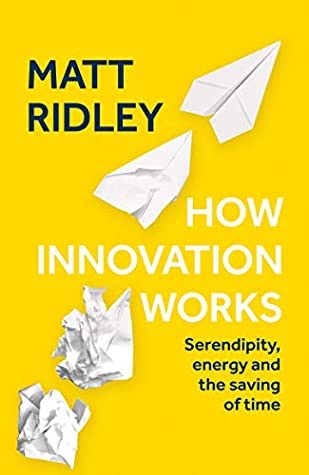More on this book
Community
Kindle Notes & Highlights
Improbable arrangements of the world, crystallized consequences of energy generation, are what both life and technology are all about.
Innovation, like evolution, is a process of constantly discovering ways of rearranging the world into forms that are unlikely to arise by chance – and that happen to be useful.
second law of thermodynamics, that entropy cannot be reversed, locally, unless there is a source of energy
Innovation, then, means finding new ways to apply energy to create improbable things, and see them
the simple explanation of why the incidence of extreme poverty is in global freefall for the first time in history: from 50 per cent of the world population to 9 per cent in my lifetime.
A steam engine proved to be ‘autocatalytic’: it drained the mines, which cut the cost of coal, which made the next machine cheaper and easier to make.
Lots of people tried to make bread-slicing machines, but they either worked poorly or they led to stale bread because it was not well packaged.
Crucially he realized that he must invent automatic
packaging of the bread at the same time lest the slices go stale.
Innovation happens when people are free to think, experiment and speculate. It happens when people can trade with each other. It happens where people are relatively prosperous,
not desperate. It is somewhat contagious.
No economist or social scientist can fully explain why innovation happens, let alone why it happens when and where it does.
tell the stories of steam engines and search engines, of vaccines and vaping, of shipping containers and silicon chips, of wheeled suitcases and gene editing, of numbers and water closets.
Chimpanzees and crows do innovate, by developing and spreading new cultural habits, but very occasionally and rather
slowly; most other animals not at all.
The income of the average Ethiopian has doubled in a decade;
Innovation often disappoints in its early years, only to exceed expectations once it gets going, a phenomenon I call the Amara hype cycle, after Roy Amara, who first said that we underestimate the impact of innovation in the long run but overestimate it in the short run.
Whenever you see a successful business, someone once made a courageous decision. PETER DRUCKER
Some time between 1690 and 1695 he even built a simple piston and cylinder in which steam could condense on cooling, causing the piston to plunge, thereby lifting a weight by a pulley. He had discovered the principle of the atmospheric engine in which it is the weight of the atmosphere that does the work once a vacuum has been created under the piston. It is a machine that sucks rather than blows.
Pumping water out of mines was the chief problem to be solved, for it was the one place where horses were difficult to use and where fuel was abundant.
Wet mines were safer than dry ones, because the fire risk was lower, but flooding kept foiling the miners.
Savery’s machine worked as follows. A copper boiler over a fire sent steam into a water-filled tank called a receiver, where it expelled the water up a brass pipe through a non-return valve. Once the receiver was full of steam, the supply from the boiler was shut off and the receiver was sprayed
with cold water, collapsing the steam inside and creating a vacuum. This sucked water up from below through a different
would be decades before the separate condenser of James Watt, the flywheel and drive shaft, and other improvements turned it into something that could be of
Was it because of the advance of science in Britain and France, exemplified by Denis Papin? Perhaps a bit, but Newcomen apparently knew nothing of that. Was it because of improvements in metallurgy of the late seventeenth century so that large brass cylinders and pistons could now be built? Partly. Was it because of the dramatic expansion of the coal-mining industry driven by the rising price of wood as British forests shrank, and with it the demand for pumping equipment? To some extent. Was it because of the expansion of trade in north-west Europe, begun by the Dutch and leading to the
...more
using a separate condenser, so that the cylinder could be kept hot, while the steam was drawn off for condensing in a cooler container.
Indeed, one source of steady and incremental improvement in the efficiency and penetration of steam engines came as a result of the publication of a journal, Lean’s Engine Reporter,
McAfee, Andrew. More from Less: The Surprising Story of How We Learned to Prosper Using Fewer Resources and What Happens Next. Simon and Schuster, 2019. Ridley, Matt. The
West, Geoffrey. Scale: The Universal Laws of Life and Death in Organisms, Cities and Companies. Weidenfeld and Nicolson, 2017. Williams, Gareth. Unravelling the Double
Rowan, David. Non-Bullshit Innovation.
The Innovation Illusion: How So Little is Created by So Many Working So Hard. Yale University Press, 2016.


